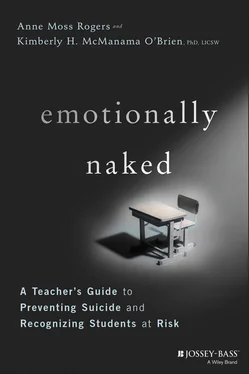“I believe this teacher saved this kid's life with all my heart. She did. It was so rewarding to see how that all played out because she had a comfort level around knowing what to do when worried about a student. She also knew when she needed some backup. I am so grateful.”
Jennifer Hamilton (She/Her/Hers), School Psychologist, Director of Psychology and Counseling at Noble and Greenough, Independent School, Dedham, Massachusetts
The purpose of this book is not to make the job of the educator harder, but to make it more meaningful. Our hope is that this book will arm you with the knowledge, tools, resources, and ideas to inspire administrators to integrate new policies and encourage impactful shifts in your school culture and curriculum to prevent suicide and promote health and wellness. It will make you aware of resources for crisis response, as well as give you tips on getting school leadership and the community behind social emotional teaching and suicide prevention, which can mean adding more staff trained in mental health to support those efforts. A lot of what you'll read here is not a teacher's responsibility to implement, but having knowledge of what that collaborative process might look like helps complete your understanding of how it should work and a teacher's role as part of a team effort. So while this book is not intended solely for teachers, that is the point of view from which we will speak. Our intention is to make you more comfortable with an uncomfortable subject because it's one that very few feel qualified to address. But given the pervasive public health problem of suicide in our youth, it's a critical conversation that all educators need to have in order to feel ready and able to effectively engage with their students. Although we refer to students who are at risk of suicide in this book, that's not to exclude educators who might be at risk. They can. And it is our hope that the information delivered will also help you recognize any colleagues, friends, and family members who are struggling and connect them with life-saving and supportive resources in the school and community.
This book is also not meant to train you as an interventionist or a counselor. Enough is asked of you. Instead we hope to help you see, notice, and pick up on which students need intervention. Learning to say, “Tell me more,” and actively listen is a powerful first step to help a suicidal student open up. And even if you are not comfortable with that, you can simply look after your students and make the school social worker or counselor aware of your concerns. Mastering the art of listening and empathically connecting to people is underrated in today's busy culture and we are often unaware of how important even the smallest gestures and acts of kindness mean to another human being. One empathetic adult is all it takes to have a positive impact on a student and change the trajectory of their life. Throughout this book we want you to ask yourself, “What kind of educator do I want to be?”
1 1.Kann, L., McManus, T., Harris, W.A., Shanklin, S.L., Flint, K.H., Queen, B., Lowry, R., Chyen, D., Whittle, L., Thornton, J., Lim, C., Bradford, D., Yamakawa, Y., Leon, M., Brener, N., Ethier, K. (2018) Youth Risk Behavior Surveillance — United States, 2017. MMWR Surveillance Summaries 67(8):1–114.
2 2.Coombs et al., 1992; Robins, Gassner, Kayes, Wilkinson, Murphy, 1959, p. 9. https://www.qprinstitute.com/uploads/QPR%20Theory%20Paper.pdf
Chapter 1 Why Are We Seeing More Mental Health Problems with Students?
“In order to achieve, you have to put wellness first.”
Jennifer Hamilton (She/Her/Hers), School Psychologist, Director of Psychology andCounseling at Noble and Greenough, Independent School, Dedham, Massachusetts
Mental health includes our emotional, psychological, and social well-being. It affects how we think, feel, and act and drives how we handle stress, relate to others, and make choices. 1 This can be impacted by the home and social environment, economic status including homelessness and food instability, early childhood adversity or trauma, physical health, and a family history of mental health diagnoses and suicide. Mental health concerns, such as depression, anxiety disorders, self-harm, post-traumatic stress disorders, and substance use disorders, significantly impact one's daily functioning, and those are the signs that educators need to look out for.
Many psychiatric disorders have their onset at adolescence. So right at the phase when their brains are still maturing and hormones are driving behavior, teenagers can develop a mental illness, making adolescence that much more challenging. Mental illness often makes teens more susceptible to suicide risk, and family history, medical history, and social stressors like trauma, grief, transitions, and relationship disruption can add to that vulnerability.
THE RISE IN TEEN MENTAL HEALTH PROBLEMS
A study by Twenge and colleagues (2019) 2 found that between 2008 and 2017, mental health problems, including self-harm behaviors, grew substantially for the youth subset of the population. They found that by 2017, 13% of youth had symptoms consistent with major depression in the previous year, which represented a 62% increase in eight years. Scholars and advocates posit a variety of reasons for the rise in mental health issues among today's youth. Technology and too much screen time, constant social comparison exacerbated by social media, emphasis on happiness and nonacceptance of difficult emotions, the academic and extracurricular rat race, helicopter parenting, transitions, and the disruption of relationships (whether that's a family divorce, death of a loved one, or loss of a romantic partner) all contribute.
When the digital age moved in, that which we thought would connect us more instead pushed us apart in many ways. It was during the early 2000s that we began to see an increase in student mental health problems. Poor sleep hygiene, the result of increased screen time and 24/7 Internet access via mobile phones, exacerbated those issues because youth sacrificed precious slumber time for late-night chats and video watching. As the digital revolution has grown, each generation has less face time with friends than the one before, which means youth are getting fewer opportunities to learn, fail, and problem solve. Add to that the fact that extended family often lives out of town and community programs and interactions have a reduced role in our lives, further fracturing the community of connection and support. Humans crave contact with each other, and lack of it can leave teenagers feeling anxious, small, insignificant, and devoid of opportunities to develop important life skills.
If you are an adult who grew up before 1995, think about how much you learned when you played games outside with friends in your neighborhood. You learned to negotiate, compromise, and argue in an effective way. There was no referee other than the peer-appointed kid who lived on the corner, so you had to work it out. Failure is a part of life and a learning opportunity, but so many students have no idea how to manage it because what little unstructured time they do have is now spent on digital screens. Victor Schwartz, MD, Clinical Associate Professor, Department of Psychiatry, NYU School of Medicine, points out that there are fewer community centers, religious-based organizations, and clubs like 4-H or Girl Scouts in today's culture (in some cases for very good reasons). These gathering places and clubs were commonplace in earlier generations and were settings where youth picked up a lot of life skills. This is where kids learned to run a program, organize something, learned how to deal with other people in planning a project. It's not the schools' fault that we've lost the whole notion of community centers, but are there ways to bring more of those skill-building opportunities in a more intentional way into academics? In Chapter 6, “Suicide Prevention Activities for Schools,” we present specific strategies and ideas that teachers from different regions are integrating into their curriculums to build that skillset. The effect of doing so reduces unhealthy coping such as self-harm, substance misuse, and suicide, and promotes more positive experiences in school and beyond.
Читать дальше












